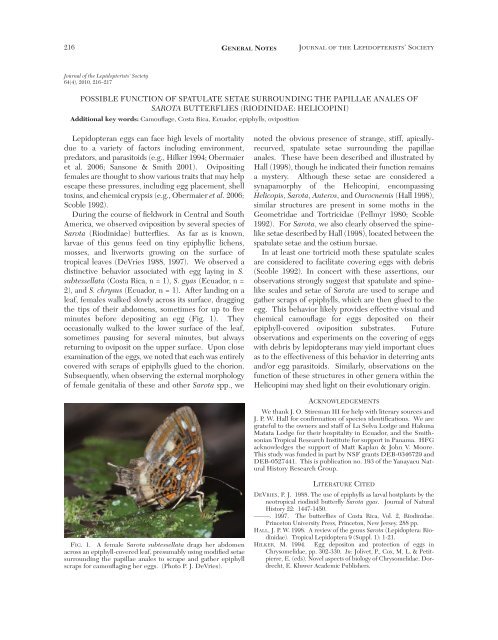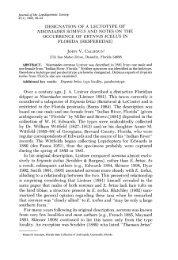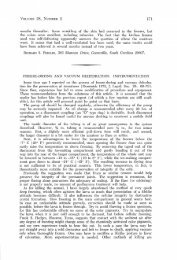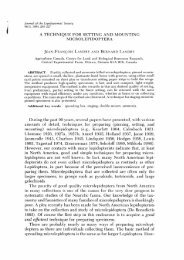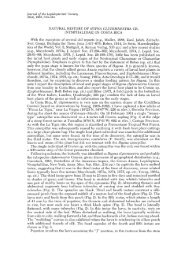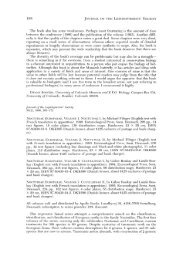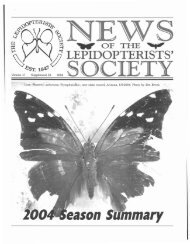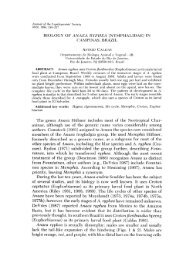POSSIBLE FUNCTION OF SPATULATE SETAE ... - Yale University
POSSIBLE FUNCTION OF SPATULATE SETAE ... - Yale University
POSSIBLE FUNCTION OF SPATULATE SETAE ... - Yale University
Create successful ePaper yourself
Turn your PDF publications into a flip-book with our unique Google optimized e-Paper software.
216216 JOURNAL <strong>OF</strong> THE LEPIDOPTERISTS’ SOCIETY<br />
GENERAL NOTES<br />
Journal of the Lepidopterists’ Society<br />
64(4), 2010, 216–217<br />
<strong>POSSIBLE</strong> <strong>FUNCTION</strong> <strong>OF</strong> <strong>SPATULATE</strong> <strong>SETAE</strong> SURROUNDING THE PAPILLAE ANALES <strong>OF</strong><br />
SAROTA BUTTERFLIES (RIODINIDAE: HELICOPINI)<br />
Additional key words: Camouflage, Costa Rica, Ecuador, epiphylls, oviposition<br />
Lepidopteran eggs can face high levels of mortality<br />
due to a variety of factors including environment,<br />
predators, and parasitoids (e.g., Hilker 1994; Obermaier<br />
et al. 2006; Sansone & Smith 2001). Ovipositing<br />
females are thought to show various traits that may help<br />
escape these pressures, including egg placement, shell<br />
toxins, and chemical crypsis (e.g., Obermaier et al. 2006;<br />
Scoble 1992).<br />
During the course of fieldwork in Central and South<br />
America, we observed oviposition by several species of<br />
Sarota (Riodinidae) butterflies. As far as is known,<br />
larvae of this genus feed on tiny epiphyllic lichens,<br />
mosses, and liverworts growing on the surface of<br />
tropical leaves (DeVries 1988, 1997). We observed a<br />
distinctive behavior associated with egg laying in S.<br />
subtessellata (Costa Rica, n = 1), S. gyas (Ecuador, n =<br />
2), and S. chrysus (Ecuador, n = 1). After landing on a<br />
leaf, females walked slowly across its surface, dragging<br />
the tips of their abdomens, sometimes for up to five<br />
minutes before depositing an egg (Fig. 1). They<br />
occasionally walked to the lower surface of the leaf,<br />
sometimes pausing for several minutes, but always<br />
returning to oviposit on the upper surface. Upon close<br />
examination of the eggs, we noted that each was entirely<br />
covered with scraps of epiphylls glued to the chorion.<br />
Subsequently, when observing the external morphology<br />
of female genitalia of these and other Sarota spp., we<br />
noted the obvious presence of strange, stiff, apicallyrecurved,<br />
spatulate setae surrounding the papillae<br />
anales. These have been described and illustrated by<br />
Hall (1998), though he indicated their function remains<br />
a mystery. Although these setae are considered a<br />
synapamorphy of the Helicopini, encompassing<br />
Helicopis, Sarota, Anteros, and Ourocnemis (Hall 1998),<br />
similar structures are present in some moths in the<br />
Geometridae and Tortricidae (Pellmyr 1980; Scoble<br />
1992). For Sarota, we also clearly observed the spinelike<br />
setae described by Hall (1998), located between the<br />
spatulate setae and the ostium bursae.<br />
In at least one tortricid moth these spatulate scales<br />
are considered to facilitate covering eggs with debris<br />
(Scoble 1992). In concert with these assertions, our<br />
observations strongly suggest that spatulate and spinelike<br />
scales and setae of Sarota are used to scrape and<br />
gather scraps of epiphylls, which are then glued to the<br />
egg. This behavior likely provides effective visual and<br />
chemical camouflage for eggs deposited on their<br />
epiphyll-covered oviposition substrates. Future<br />
observations and experiments on the covering of eggs<br />
with debris by lepidopterans may yield important clues<br />
as to the effectiveness of this behavior in deterring ants<br />
and/or egg parasitoids. Similarly, observations on the<br />
function of these structures in other genera within the<br />
Helicopini may shed light on their evolutionary origin.<br />
ACKNOWLEDGEMENTS<br />
We thank J. O. Stireman III for help with literary sources and<br />
J. P. W. Hall for confirmation of species identifications. We are<br />
grateful to the owners and staff of La Selva Lodge and Hakuna<br />
Matata Lodge for their hospitality in Ecuador, and the Smithsonian<br />
Tropical Research Institute for support in Panama. HFG<br />
acknowledges the support of Matt Kaplan & John V. Moore.<br />
This study was funded in part by NSF grants DEB-0346729 and<br />
DEB-0527441. This is publication no. 193 of the Yanayacu Natural<br />
History Research Group.<br />
FIG. 1. A female Sarota subtessellata drags her abdomen<br />
across an epiphyll-covered leaf, presumably using modified setae<br />
surrounding the papillae anales to scrape and gather epiphyll<br />
scraps for camouflaging her eggs. (Photo P. J. DeVries).<br />
LITERATURE CITED<br />
DEVRIES, P. J. 1988. The use of epiphylls as larval hostplants by the<br />
neotropical riodinid butterfly Sarota gyas. Journal of Natural<br />
History 22: 1447-1450.<br />
–––––. 1997. The butterflies of Costa Rica, Vol. 2, Riodinidae.<br />
Princeton <strong>University</strong> Press, Princeton, New Jersey. 288 pp.<br />
HALL, J. P. W. 1998. A review of the genus Sarota (Lepidoptera: Riodinidae).<br />
Tropical Lepidoptera 9 (Suppl. 1): 1-21.<br />
HILKER, M. 1994. Egg depositon and protection of eggs in<br />
Chrysomelidae, pp. 302-330. In: Jolivet, P., Cox, M. L. & Petitpierre,<br />
E. (eds). Novel aspects of biology of Chrysomelidae. Dordrecht,<br />
E. Kluwer Academic Publishers.
VOLUME 64, NUMBER 4 217<br />
OBERMAIER, E., A. HEISSWOLF, B. RANDLK<strong>OF</strong>ER, & T. MEINERS. 2006.<br />
Enemies in low places – insecs avoid winter mortality and egg<br />
parasitism by modulating oviposition height. Bull. Ent. Research<br />
96: 337-343.<br />
PELLMYR, O. 1980. Morphology of the genitalia of Scandinavian<br />
brachypterous female Geometridae (Lepidoptera). Ent. Scand.<br />
(Copenhagen), 11: 413-423.<br />
SANSONE, C. G. & J. W. SMITH, JR. 2001. Natural mortality of Helicoverpa<br />
zea (Lepidoptera: Noctuidae) in short-season cotton.<br />
Env. Ent. 30: 112-122.<br />
SCOBLE, M. J. 1992. The Lepidoptera. Form, function, and diversity.<br />
Oxford <strong>University</strong> Press, Oxford, U.K. 404 pp.<br />
HAROLD F. GREENEY, Yanayacu Biological Station and<br />
Center for Creative Studies, Cosanga, Ecuador c/o Foch<br />
721 y Amazonas, Quito, Ecuador, email:<br />
revmmoss@yahoo.com, CARLA M. PENZ & PHILLIP J.<br />
DEVRIES, <strong>University</strong> of New Orleans, Department of<br />
Biological Sciences, New Orleans, LA 70148, and THOMAS<br />
R. WALLA, Department of Biology, Mesa State College,<br />
1100 North Avenue, Grand Junction, CO 81501, USA.<br />
Received for publication 5 March 2009, revised and accepted 23<br />
January 2010<br />
Journal of the Lepidopterists’ Society<br />
64(4), 2010, 217–218<br />
LIMENITIS ARTHEMIS ASTYANAX (FABRICIUS) (NYMPHALIDAE) SIPPING CERCOPID-SPITTLE ON<br />
TALL GOLDENROD, SOLIDAGO ALTISSIMA L. (ASTERACEAE)<br />
Scores of insects use the resources provided by<br />
goldenrod plants (Solidago spp.). In the Finger Lakes<br />
Region of New York alone, Root & Cappuccino (1992)<br />
documented 138 species of insects that feed on leaves,<br />
stems, or sap of tall goldenrod, Solidago altissima L.<br />
With its prodigious flowering display in late summer and<br />
early autumn, S. altissima is also visited by numerous<br />
species of pollen-, nectar-, flower-, and seed-feeding<br />
insects (Gross and Werner 1983; Sholes 1984).<br />
Therefore, I was not surprised during my studies of<br />
goldenrod in Virginia to see adults of the red-spotted<br />
purple, Limenitis arthemis astyanax, making repeated<br />
visits to S. altissima in early September—until I realized<br />
that the plants had yet to open any flowers. A closer<br />
examination of the interaction revealed a very unusual<br />
behavior: The butterflies were imbibing spittle excreted<br />
by the nymphs of spittlebugs (Cercopidae) that were<br />
abundant on S. altissima (Fig. 1).<br />
Adults of the genus Limenitis are known to have rather<br />
eclectic feeding habits. In addition to nectar, they also<br />
feed on rotting fruit, dung, and carrion (Downes 1973).<br />
They have also been reported to feed on sap exuding<br />
from woodpecker holes in trees and on honeydew<br />
excreted by aphids (Rosenberg 1989). However, there are<br />
apparently no previous reports of L. a. astyanax or any<br />
other species of butterfly, utilizing the excretions of<br />
spittlebugs. It is quite possible that this behavior has not<br />
been officially documented for any insect.<br />
It might seem like a small step from feeding on aphid<br />
honeydew to spittlebug excretions, as both aphids and<br />
spittlebugs tap into the flow of plant sap and excrete<br />
copious amounts of liquid waste. However, the<br />
similarities end there. Aphids feed on phloem sap, which<br />
is rich in sugars manufactured by the plant through<br />
photosynthesis. Because aphids obtain more<br />
carbohydrates than they need from phloem sap, their<br />
excretions (honeydew) are rich in sugars. Many insects,<br />
most notably ants, are able to take advantage of this<br />
honeydew as a source of sugar.<br />
In contrast to aphids, spittlebugs ingest xylem sap,<br />
which is relatively dilute, with small amounts of inorganic<br />
nutrients and amino acids and smaller amounts of sugar<br />
(Wiegert 1964a; Horsfield 1977). Spittlebug nymphs<br />
introduce bubbles into their liquid excrement and cover<br />
their bodies with the foamy spittle, which may serve as<br />
protection from predation or desiccation (Guilbeau 1908;<br />
Weaver and King 1954; Wiegert 1964a; Whittaker 1970;<br />
Turner 1994). Spittlebugs extract most of the sugars and<br />
other nutrients from the xylem sap, such that spittle is<br />
expected to be of little nutritional benefit to other insects<br />
(Wiegert 1964b). It has been suggested that the spittle<br />
may be toxic to other insects due to the presence of<br />
ammonia (Turner 2000).<br />
The fact that L. a. astyanax repeatedly returned to<br />
spittle masses raises several questions. For instance, do<br />
the butterflies sip spittle to their own detriment, or do<br />
they gain a net benefit from it? If the latter, then what is<br />
the nature of the benefit? Are there undigested amino<br />
acids from the xylem or nutrients from decaying exuviae<br />
and small organisms trapped in the spittle, or do the<br />
butterflies simply use the spittle as a source of moisture?<br />
Would the costs and benefits of sipping spittle differ<br />
depending on the species of cercopid producing the<br />
spittle?<br />
The most abundant spittlebug nymph on S. altissima in<br />
Virginia in September is the sunflower spittlebug<br />
(Clastoptera xanthocephala Germar), a rather<br />
polyphagous species that is best known for feeding on<br />
plants in the Asteraceae. Nymphs of two other cercopid<br />
species, Philaenus spumarius (L.) and Lepyronia<br />
quadrangularis (Say), are common on S. altissima during<br />
the late spring and early summer, but I have not observed


